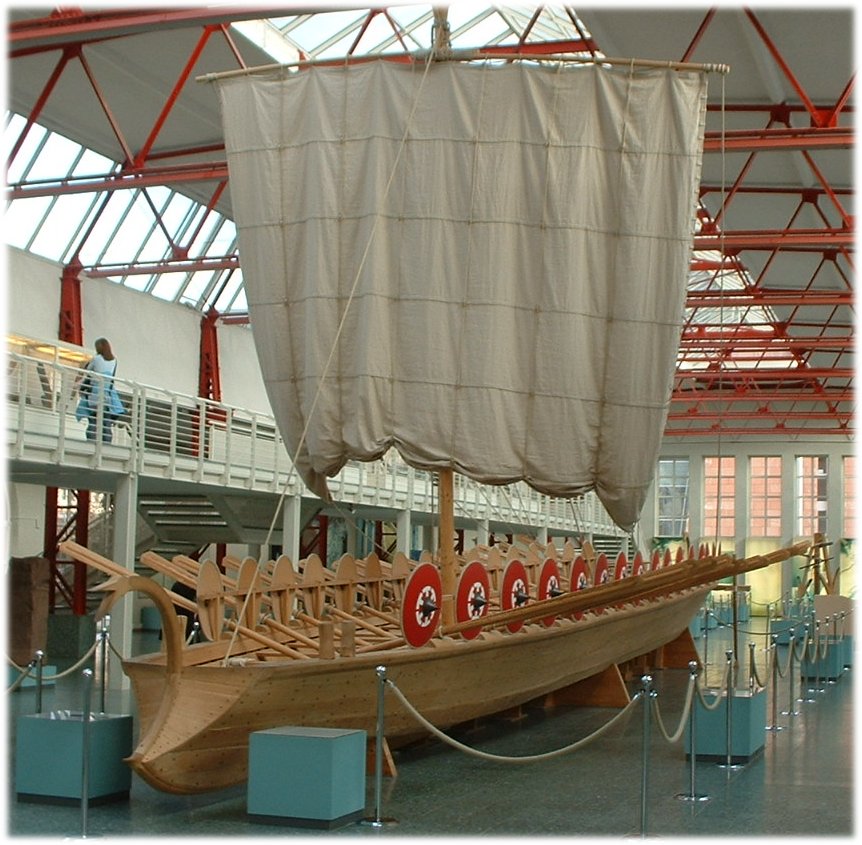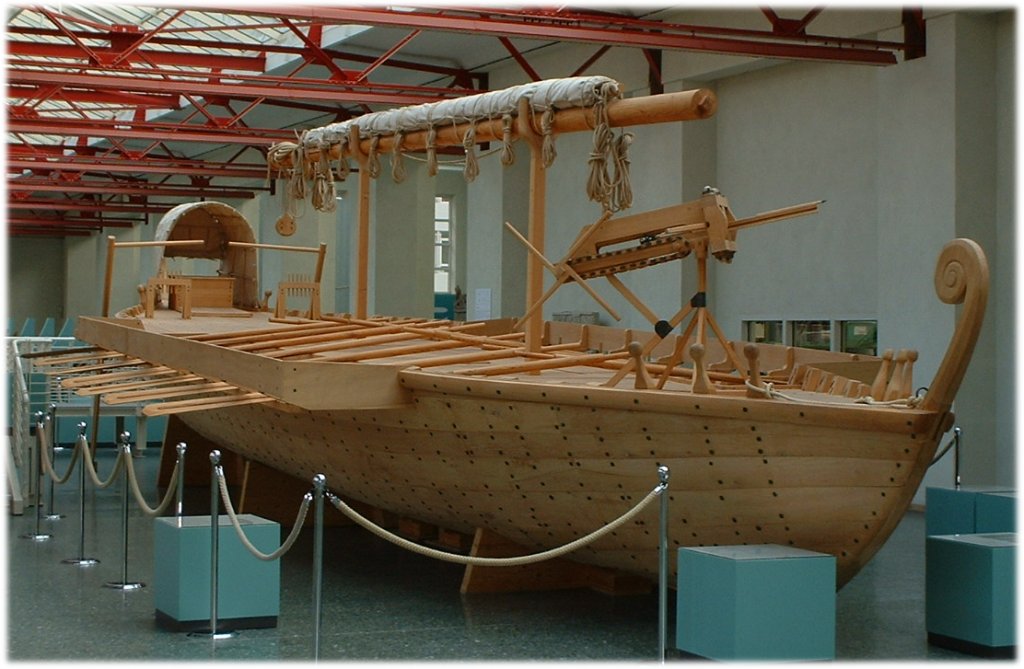« Ship's, windows and printing | Main | Superb models »
January 03, 2007
Roman Navy on the Rhine
In the 1980's a most interesting find was made while a site near the modern bank of the Rhine was being excavated for a new building project in Mainz. Six wooden ships were uncovered buried under centuries of mud. These were in a remarkable state of preservation and archeologists were very excited by their discovery because they were among the best examples of Roman ships yet discovered. Even better was the fact that two turned out to be military vessels, providing a wonderful insight into a type, until then, known only from friezes and funeral ornamentation. These have been reconstructed in full size and now form the centre piece of a museum built near the site on which they were originally discovered. One is a small, lean and very businesslike galley, the other apparently a patrol ship, is slightly broader in the beam, decked and carries the Roman equivalent of a machine gun on her foredeck.

The reconstructed Roman war galley at the museum of Antique Ship Travel in Mainz. Note the slim lines and businesslike bow ram - the Roman equivalent I suspect of a modern Fast Attack Craft!
Among the other vessels that were uncovered, several were obviously for trade and commerce, but the construction is the most interesting feature. These ships are all of them 'carvel' built over stong ribs. That is to say, they are built of planks laid edge to edge and not overlapping as the later Nordic ship's were built. The planks are broad and fastened to the frames with 'clenched' iron nails, making the whole structure very strong. The seams were paid with rope yarn (something which was still being done right up to the time Brunel started the system of building in iron or steel in the 1840's!) and then the hull painted over with a bituminous mix to seal them. The hulls all have a flattened bottom in the waist (the broadest part of the hull) with the bow and stern shaped to provide a clean 'entry' and 'exit' from the water. The two military examples both carry a 'ram' bow, clearly capable of doing considerable damage. Even more interesting is the manner in which they dealt with the very difficult design problem of creating the "turn of the bilge", since a seam along the junction between the ship's bottom and the first strake or plank on the side would invariable 'work' and leak badly. The Roman designers solved it by cutting a plank with a 90 degree bend built in from a single tree trunk. To do this they needed to saw it from the heart of an oak tree trunk that would have been at least 150 yeras old. Tool marks show that they used saws, chisels and adzes to cut the timbers and shape them and some of the joints between planks, particularly where there is a need for strength, are 'chamferred' so that the joint is a long diagonal rather than a vertical seam. Analysis of the galley's hull shape and tests carried out with it, have shown that it could reach speeds of around 28 km/h - a speed quite capable of impaling it into any enemy craft attempting to cross the river!

Broader and heavier than her counter-part, this ship is thought to have been a 'patrol vessel'. The outrigger arrangment for the oars clear the central part of the hull, allowing it to be decked over and giving the crew a sheltered space when not rowing or standing guard watches.
The Roman Naval organisation was impressive, even for a 'Fleet' based entirely on the river. It followed the same pattern as any of the seagoing fleets maintained by the Roman Empire and the command cascade included structures and command ranks we would have no trouble recognising today. An 'Admiralty' sat at the top of the tree, probably in Rome itself, and command then devolved to Fleet Commanders, Squadron Commanders and the commanders of individual ships. Fleets were based in the Black Sea, the Adriatic, the Levantine shore, Alexandria, Tripoli and Southern Gaul. There was one based on the Cinque Ports in the British Isles and the Rhine, with its Commander based at Köln. Each ship had two commander's, the one responsible for the management of the ship itself, the other for the fighting men aboard it and the actual fighting. A Division of Command that again had echoes right into the Middle Ages, being reflected even in Nelson's Navy by the fact that ship's carried a Captain and a "Sailing Master" - the man responsible for the navigation and sail handling originally, but, by Nelson's time, a Warrant Officer whose position was as an assistant to the officers with responsibility for the maintenance of the ship's charts and other navigational equipment as well as to ensure that the navigation was carried out correctly.
It seems these ships survived because they were abandoned, probably deliberately damaged, after the 'Catastrophe on the Rhine' in 406AD when Germanic tribes swept across the frozen Rhine and stormed several Colonia, over running them. At that time the Rhine was the border to the Empire, and once it had been penetrated it rapidly crumbled, the Roman's withdrawing progressively south from there on in. The soon forgotten ships sinking into their mud berths to be preserved and rediscovered some 1,600 years later. I suppose that, in some ways, the 'Catastrophe' has provided us with some truly remarkable examples of Roman ships, beautifully adapted and built for the protection of the river and an even more remarkable insight into how they were built.
Posted by The Gray Monk at January 3, 2007 07:14 AM
Trackback Pings
TrackBack URL for this entry:
http://mt3.mu.nu/mt/mt-tb.cgi/4878